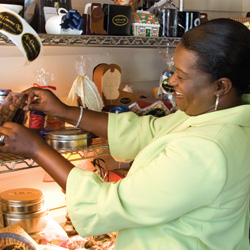Collaborating with other entrepreneurs can be the key to growing your business when you are the sole owner, have a small staff or have limited networking capabilities. Implementing strategies with other entrepreneurs to increase your bottom line can be done through effective collaborations. This could be a verbal agreement between you and another company to offer a complimentary service to one another or partnering to purchase a booth at a trade show to cut down costs.
Collaborating to Create Referrals
Many female business owners find collaborating with other entrepreneurs is critical to growth. Shana M. Prichard of San Antonio-based Realign finds collaboration necessary for her organizational consulting firm. Just last year, she partnered with Fintan Technologies to offer a Microsoft Outlook course to their clients, and this partnership has brought her a steady clientele. Prichard says the idea came about from a Lunch Connection meeting, which is an event sponsored by the San Antonio chapter of the National Association of Women Business Owners.
“My best clients and vendors involve collaboration that goes far beyond just a name on a business card,” Prichard adds. “It’s about getting to know business owners and how they run their business, treat their vendors and employees, and ultimately, I can recommend them to my clients.” Prichard also collaborates with other businesses by establishing relationships that over time lead to referrals. Recently, a potential client contacted her because she was looking for a certified public accountant, so Prichard referred her to Chase & Chase in San Antonio. The customer was so pleased with the referral that she eventually became a Realign client. Prichard has also found referring business to San Antonio-based Check Point Payroll has proved beneficial for both companies. Prichard and Check Point Payroll owner Marisa Sarabia have developed a friendship where they rely on one another for advice and refer clients to each other. “I honestly don’t have a sales staff right now, and 99 percent of my business comes from referrals,” Sarabia says. “Collaborating has been vital to the growth of my business.” She has also partnered with other businesses that offer human resources and benefits to complement her payroll service to clients.
Many business owners find that through collaboration they can lean on other entrepreneurs to share ideas, strategies and concerns. This is especially important when you have a small firm and don’t have access to a board of advisors or have the money to hire consultants. For Prichard, being able to talk with other entrepreneurs has also been a priceless form of collaboration. “Having another business owner to call and discuss ideas with is worth as much or more to me as a referral,” she says. “Really, the greatest benefit is knowing you have a quality business owner to ask about the situation.”
Forming Partnerships
For many businesses, collaborating can be taken to the next level, where two or more companies join forces. This is often done to decrease competition, meet the need to be more global or leverage resources when marketing. Companies participating in alliances, according to Small Business Notes, report that as much as 18 percent of their revenues come from their partnerships. Heather Felty, chief executive officer of San Antonio-based and woman-owned Fintan Technologies, says Fintan was actually started years ago by collaborating with another information technology company. They subcontracted for one another and realized joining forces would be that much smarter. Fintan is growing its business again by collaborating with TechSage Solutions, also of San Antonio. With TechSage, Felty says, they are first forming a strategic alliance to test the waters for several months before they make it official in January.
“The idea is not that you are getting rid of your competition, but you are creating ‘co-opetition’ to help each other grow,” Felty explains.
Instead of just focusing on commercial business, Fintan and TechSage will be able to create a niche in the government sector since TechSage (a veteran-owned company) specializes in this area. “I hope more businesses learn strategically to collaborate more because it cuts down on overhead expenses and increases productive resources,” Felty says. “This is the way to move in the future.” She adds, “Companies are going away from ‘we do everything’ and are working with others who specialize. This allows small companies to focus on what they do best. In the end, this provides better quality of services and is a greater benefit to clients.”
For TechSage owners Elizabeth and John Hill, collaborating is the only way to go in a highly competitive marketplace like San Antonio.
Elizabeth Hill says while the two companies will keep their identities, they will share ownership, but go after business with added manpower and resources behind them. Business owner Carol Trostle of Trostle & Associates in San Antonio has also found through collaboration she can provide total solutions to her clients in the customer and call center industry. As the CEO of her business, she’s able to provide her clients a one-stop shop by bringing in experts or subcontractors to provide specialized services to her customers. After she does an initial assessment with a client to find out their needs, she will put a team of experts together to get the project done. With this philosophy, she’s been able to win more business from those same clients, who see proven results. She says one of her banking clients was looking to implement an employee incentive program. After bringing in an expert on Excel spreadsheets who developed a formula on how to award employees, the bank hired Trostle and her team to work with its other departments.
“I can’t do it all, so what I do is find out the client’s needs and pull together a team of people who have specific skills. Clients like it because it provides one solution,” Trostle says. But collaborating is something Trostle learned the hard way. She admits when she first started more than a decade ago, she put employees on payroll for a project and realized after the project was over she didn’t have continuous work for them and had to let them go. Linda Mariani, president of The Corporate Troubleshooter, LLC, who works with Trostle on various projects, says she believes collaborating is the “perfect business model” for her full-service management consulting firm because there’s no unnecessary overhead or unused talent. She adds while Trostle’s and her businesses are similar because they bring in experts to work on a project, they are able to complement each other because Trostle is a recognized expert in customer service business practices, and Mariani’s specialties are in analytics and the technical side. Collaboration also saves the client money, Mariani adds, because the two entrepreneurs bring in individuals who are experienced and specialize in a particular area rather than a team of people who may be developing their skills.
“Our teams are made up of people who have a proven record of getting results. Not everyone realizes they can’t be everything. You try to do what you can without overspending and too much overhead,” says Mariani, who has served as chief operating officer at several companies.
With many entrepreneurs, efficiency is critical to maintaining success and profitability. And most business owners also agree that for collaborations to be effective, they must start with getting to know the other business owner and slowly building trust, then strategizing together to grow their businesses.
Author:
Melissa S. Monroe









0 Comments